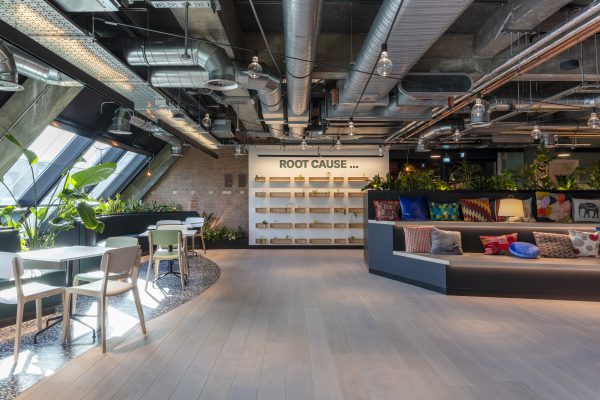Ben Hancock of Oscar Acoustics answers readers’ questions.
Acoustic spray was applied to the concrete slabs of Herbal House in London as part of an office refurbishment scheme by TP Bennett
What is acoustic design and why is it important?
Acoustic design is the fine tuning of sound for a specific interior space. While architects respond to design challenges covering aesthetics and usability, an area often overlooked is the importance of acoustics and the impact it can have on indoor environments and their occupants. Noise has been shown to be a risk factor for both physiological and psychological health, so acoustic design needs to remain a key consideration when creating and adapting spaces.
In 2021 we conducted a survey asking specifiers and architects how important acoustic design had become in their building projects. We found that despite offering professional guidance, nearly one in two architects said that many of their clients‘ aren’t interested in end user health’.
In our most recent survey, we polled 2000 office employees and employers across Great Britain on workplace noise. We discovered that a quarter of bosses said that ‘not much’ acoustic design consideration had been given to their office, despite the fact that more than half said it was important to their organisation. Shockingly, 60 per cent of employees confirmed they are unable to concentrate in the office and are delivering poor quality work due to loud workspaces.
When should you use an acoustics expert?
It won’t surprise you that I believe you should always consult an acoustic expert when it comes to the design of buildings. Acoustics are an important aspect of the modern interior space. When you get the acoustics right, people will enjoy using it without a second thought. Get it wrong and the space will become a sonic battleground that users cannot wait to escape from.
What are the key architectural considerations for good acoustic design?
We understand that for architects it’s vital that the acoustic solution they choose will not compromise the overall design and aesthetic of a space. Our acoustic spray finishes blend in seamlessly, following the lines of whatever is underneath. This enables designers to achieve perfect, sweeping curves and shapes without the acoustic treatment appearing as an afterthought.
How do you determine the appropriate level of acoustics for any given project?
Many commercial projects now take on acoustic consultants who can specify the required acoustic treatment based upon their calculations of the space and what it will be used for. For those that don’t have acoustic consultants, we offer free acoustic appraisals, and based on our experience we can often advise what specification will be appropriate. We are also able to a acoustically model a space.
How can you communicate and get client approval for particular levels of acoustic performance – especially when it might entail additional cost?
The underlying financial opportunities should be a key motivator for clients as quality sound absorption will pay for itself through better productivity, reduced sickness leave of employees and return custom.
How should acoustics be incorporated into the design process to ensure these aims are successfully achieved?
From our point of view, deciding on the project design concept and which of our five products will suit it best. We offer the smoothest acoustic plaster available, deliberately industrial acoustic sprays and everything in between. Budget usually plays a part as well, so we pride ourselves on having a suitable product for all projects.
What are the most common mistakes people make when anticipating the acoustic impact of their designs?
Quite often the shape of the substrate itself is not taken into consideration. We get a lot of architects contacting us, saying that they have been told they need a Class A absorber and have therefore over specified the required depth of our product. When spraying onto a profile or rib deck metal sheet, our products dramatically increase in performance over the worst case published acoustic data onto concrete slab. Our technical data and expertise enable us to value engineer for our clients, saving on material depth, labour and overall programme duration.
What’s the best way to test the acoustic performance of different design solutions?
Whilst you can carry out before and after testing on site with sound reading equipment, there really is no need with the advanced acoustic modelling software that acoustic consultants use nowadays. This software prevents the need for trial and error and provides very accurate results.
What are the issues involved in retrofitting existing buildings to improve environmental performance?
Areas heavily congested with services are usually the biggest issue. We normally spray our acoustic treatments before these go in for extremely fast install times. When there are existing services, we spend more time carefully wrapping and protecting them before installation. With our SonaSpray range we are able to renovate a space whilst acoustically treating it at the same time. SonaSpray is the only acoustic product assessed by the testing body UL to be compatible with applying directly onto untidy cementitious fire spray. It is also the only acoustic product to be allowed to butt up against intumescent steelwork, instead of a 50mm shadow gap with expensive and time-consuming stop beads.
For further information visit www.oscar-acoustics.co.uk
Source: Architecture Today

